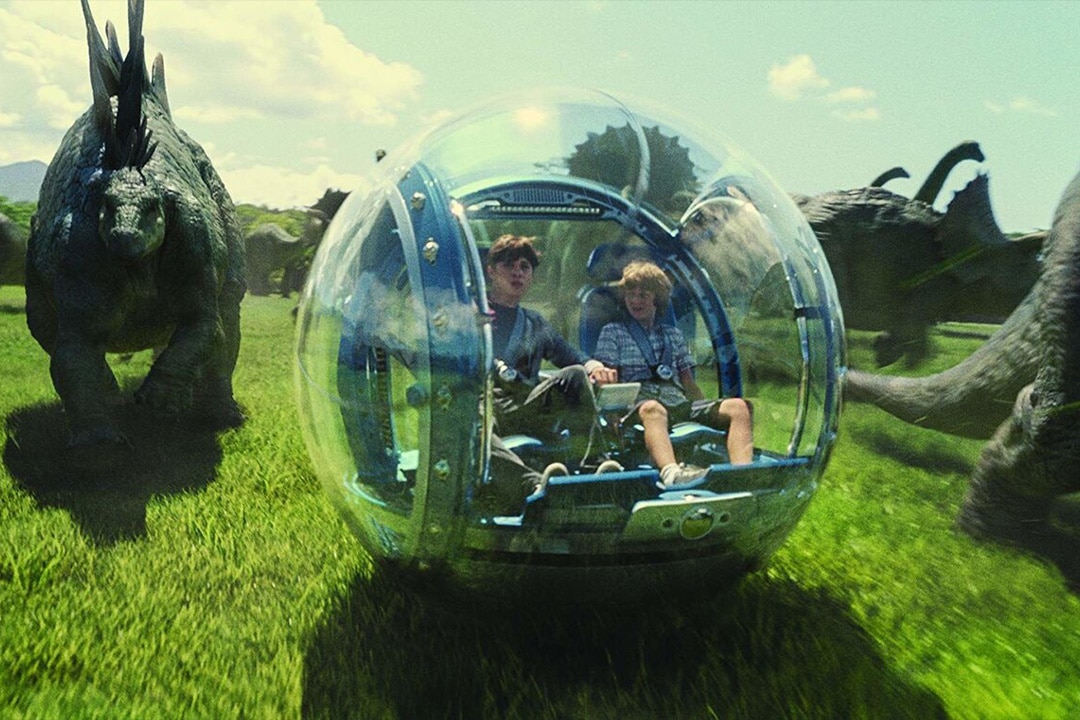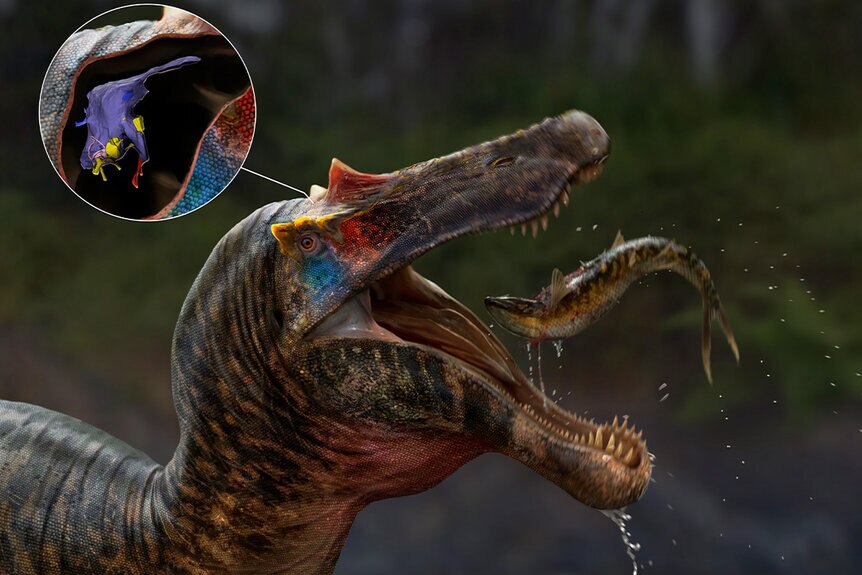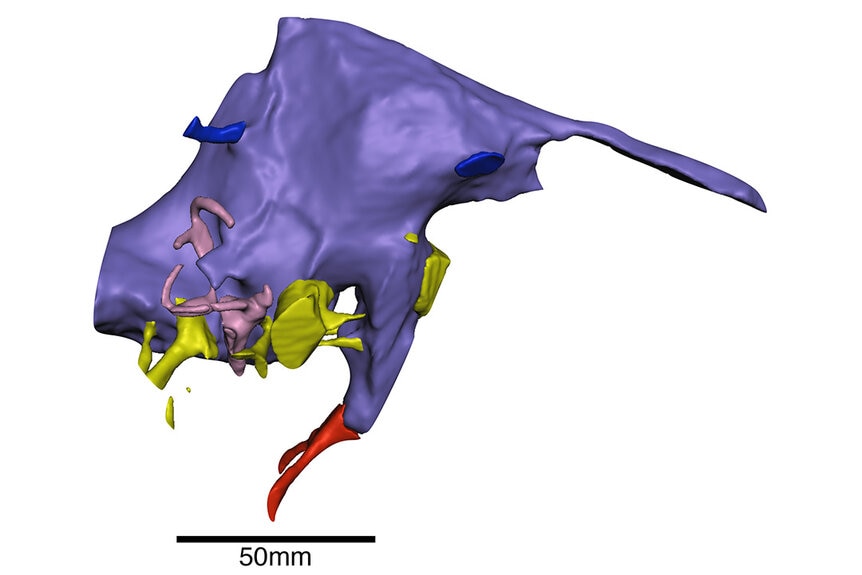Create a free profile to get unlimited access to exclusive videos, sweepstakes, and more!
Reconstructing the brain of the largest carnivorous dinosaur to ever live
It's so little brain for so much brawn.

The scientific masterminds who worked at Jurassic Park and its follow up attempt, Jurassic World set out to physically restore dinosaurs to the world. Their creatures, forcibly reconstructed from an ancient genetic soup, would present an incredible opportunity for scientific discovery. In addition to providing a life-changing experience (one way or another) for park-goers, paleontologists and biologists around the world would flock to the park for an opportunity to see and study these animals in the flesh.
Journals would be flooded with a wave of papers describing everything about them, from their internal morphology to their hunting, mating, and social behaviors. For better or for worse, today’s paleontologists don’t have access to living facsimiles of the animals they study. Instead, they rely on fossilized remains and increasingly complex technologies to achieve the next best thing.
RELATED: Early dinosaurs had complex, age-specific social behaviors
Lacking the ability to clone dinosaurs of their own to study, Chris Barker and Neil Gostling — both from the Institute for Life Sciences at Southampton University — and a team of colleagues recently reconstructed the brain of a spinosaur in the lab. The brain models and their potential implications were recently published in the Journal of Anatomy.
“You think of allosaurs or tyrannosaurs, they’re quite boxy with short snouts. Compare that to spinosaurs and it’s almost crocodile-like in shape and form, and we think they’re eating fish some of the time. There’s some debate about how much time they’re spending in the water and how much fish they’re eating. Having brain case data is important because you can extract paleoneurological information to help infer behavior,” Barker told SYFY WIRE.
Studying fossils in this way is an exercise in extracting as much information as possible out of the incomplete data we can pull out of the ground. Fossilization is fickle even under the best of circumstances and soft tissues rarely make the cut. That means scientists looking for information about the brains of long-dead dinosaurs have to lean on the shape of the brain case and comparisons with living animals.
Fortunately, the team had access to two fossilized spinosuar skulls. Unfortunately, they were broken into pieces and trapped inside the rock. Recreating a digital representation of the intact braincase was a laborious process several years in the making. The team started by taking CT scans of the specimens at several angles and then stitched those together with imaging software.
RELATED: Dinosaurs didn’t roar, they cooed, just like their bird descendants
“That was quite a long process. When the brain case was first out of the ground it was in three pieces, in a single block of matrix. We weren’t able to pick out the bone from the rock very clearly. Then it was prepared beautifully and we were able to get three separate pieces of fossil bone that you could roughly put back together,” Gostling said.
Due to erosion, some of the places where the pieces should have come together had worn away, complicating the effort to put them back together in the exact right orientation. Once they did, they had a map of the spinosaur brain and inner ear’s surface features, something scientists call an endocast. That image shows where all of the major areas of the brain are, but it can’t tell scientists what was happening in the soft tissue itself. It provides a view of the overlying morphology in the space left inside the skull. Despite the inherent limitations of this kind of work, researchers were still able to uncover valuable information about how spinosaurs lived and behaved.
The endocast demonstrates that the olfactory system projects further forward than other theropods and the orientation of the semicircular canals give some idea how well these animals — the largest carnivorous dinosaurs to ever walk the earth — could have stabilized their vision. Scientists also suspect that spinosaurs could hear at very low frequencies which may have been helpful for long-distance communication.
Perhaps surprisingly, they didn’t find any dramatic specializations in the brain which might relate to the unique semi-aquatic hunting behaviors of spinosaurs. But even that can tell us something about the evolution and adaptive ability of theropod dinosaurs.
RELATED: Were dinosaurs way smarter than we previously thought?
“The brain isn’t grossly different from the other theropods. It sort of looks like it’s the elongation of the jaw and the pointed teeth, rather than the boxy skull, which is allowing them to maybe take advantage of fish. And their brains are sort of pre-adapted, so it’s not a big leap,” Gostling said.
Gostling noted that even in living animals, some behaviors are controlled by small collections of cells which don’t necessarily leave any lasting evidence of their presence after an animal dies. With that in mind, it’s not entirely shocking that they wouldn’t find a neurological neon sign pointing to the fish-hunting part of the brain. It might also suggest that brains are more malleable than we think, and all we really need to become the rulers of our own domain is the right opportunity to present itself.
Sometimes that opportunity is a biological theme park where tourists can pay incredible sums for the opportunity to be eaten alive. Catch the entire Jurassic franchise, available from Universal Pictures.




























